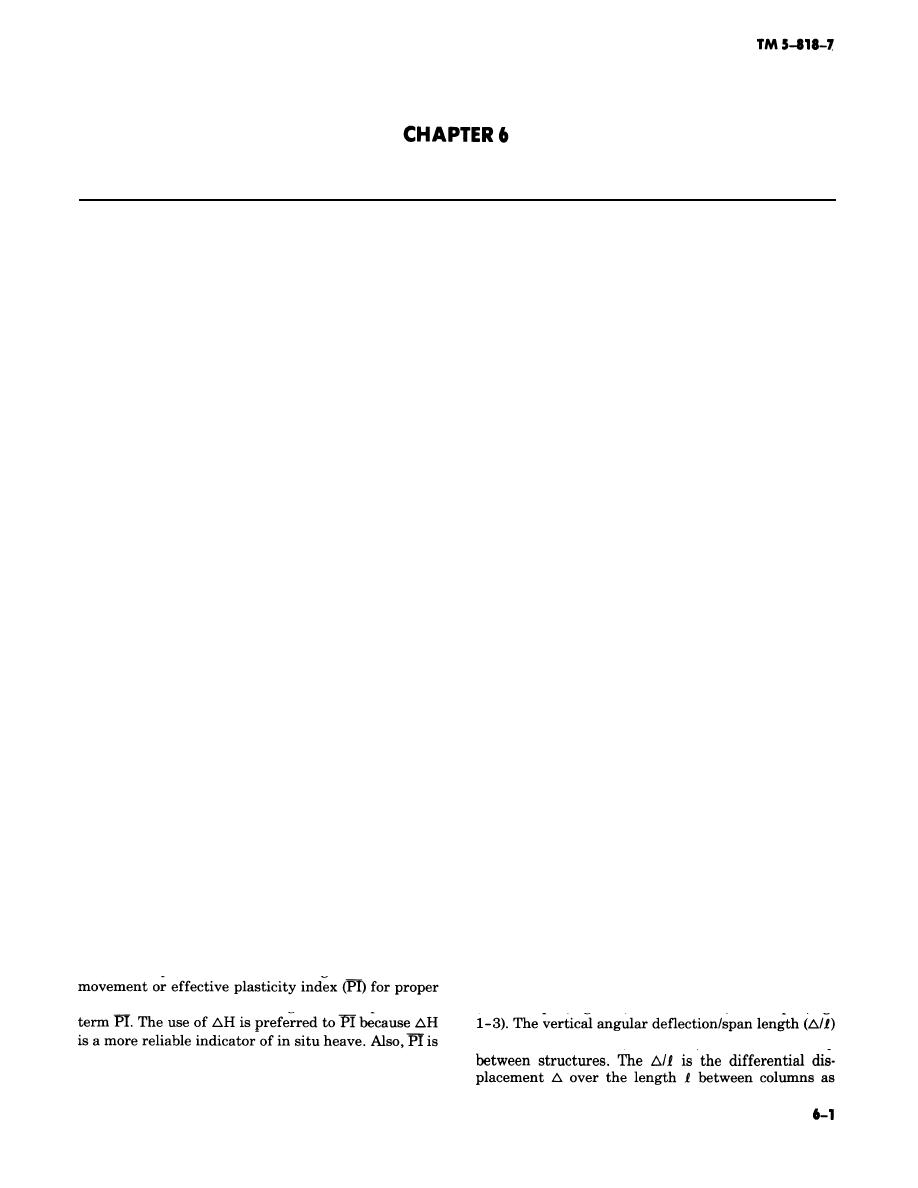
DESIGN OF FOUNDATIONS
6-1. Basic considerations
ing soil, rock, or sand. Pervious sand strata may pro-
vide a path for moisture flow into nearby swelling soil.
a. Planning. Swelling of expansive foundation soils
(1) Shallow individual or continuous footings.
should be considered during the preliminary design
Shallow individual or long continuous footings are of-
phase and the level of structural cracking that will be
ten used in low swelling soil areas where the predicted
acceptable to the user should be determined at this
footing angular deflection/span length ratios are on
time.
the order of 1/600 to 1/1000 or 0.5 inch or less of
(1) The foundation of the structure should be de-
movement.
signed to eliminate unacceptable foundation and struc-
(2) Stiffened mats (slabs). Stiffened mat founda-
tural distress. The selected foundation should also be
tions are applicable in swelling soil areas where pre-
compatible with available building materials, con-
dicted differential movement AH may reach 4 inches.
struction skills, and construction equipment.
The stiffening beams of these mats significantly re-
(2) The foundation should be designed and con-
duce differential distortion. The range provided in ta-
structed to maintain or promote constant moisture in
ble 6-1 for beam dimensions and spacings of stiffened
the foundation soils. For example, the foundation
slabs for light structures normally provides an ade-
should be constructed following the wet season if pos-
quate design.
sible. Drainage should be provided to eliminate ponded
(3) Deep foundations. A pile or beam on a drilled
water. Excavations should be protected from drying.
shaft foundation is applicable to a large range of foun-
Chapter 7 describes the methods of minimizing soil
dation soil conditions and tends to eliminate effects of
movement.
heaving soil if properly designed and constructed (para
b. Bearing capacity. Foundation loading pressures
6-4). The type of superstructure and the differential
should exceed the soil swell pressures, if practical, but
soil movement are usually not limited with properly
should be sufficiently less than the bearing capacity to
designed deep foundations. These foundations should
maintain foundation displacements within tolerable
lead to shaft deflection/spacing ratios of less than
1/600.
amounts, Present theoretical concepts and empirical
correlations permit reasonably reliable predictions of
d. Superstructure systems. The superstructure
ultimate capacity, but not differential movement of
should flex or deform compatibly with the foundation
the foundation. Factors of safety (FS) are therefore ap-
such that the structure continues to perform its func-
plied to the ultimate bearing capacity to determine
tions, contributes aesthetically to the environment,
safe or allowable working loads consistent with tolera-
and requires only minor maintenance. Frame construc-
ble settlements. Further details on bearing capacity
tion, open floor plans, and truss roofs tend to minimize
are presented in TM 5-818-1.
damage from differential movement. Load bearing
walls tend to be more susceptible to damage from
c. Foundation systems. An appropriate foundation
should economically contribute to satisfying the func-
shear than the relatively flexible frame construction.
tional requirements of the structure and minimize dif-
Wood overhead beams of truss roof systems provide
ferential movement of the various parts of the struc-
structural tension members and minimize lateral
ture that could cause damages. The foundation should
thrust on walls. Table 6-2 illustrates the relative flexi-
be designed to transmit no more than the maximum
bility provided by various superstructure systems.
tolerable distortion to the superstructure. The amount
(1) Tolerable angular deflection/length ratios. The
of distortion that can be tolerated depends on the de-
ability of a structure to tolerate deformation depends
sign and purpose of the structure. Table 6-1 illustrates
on the brittleness of the building materials, length to
foundation systems for different ranges of differential
height ratio, relative stiffness of the structure in shear
and bending, and mode of deformation whether heave
selection of the foundation. Figure 6-1 explains the
(dome-shaped, fig. 1-2) or settlement (dish-shaped, fig.
that can be tolerated, therefore, varies considerably
not a satisfactory basis of design in situations such as a
5-foot layer of highly swelling soil overlying nonswell-


 Previous Page
Previous Page
